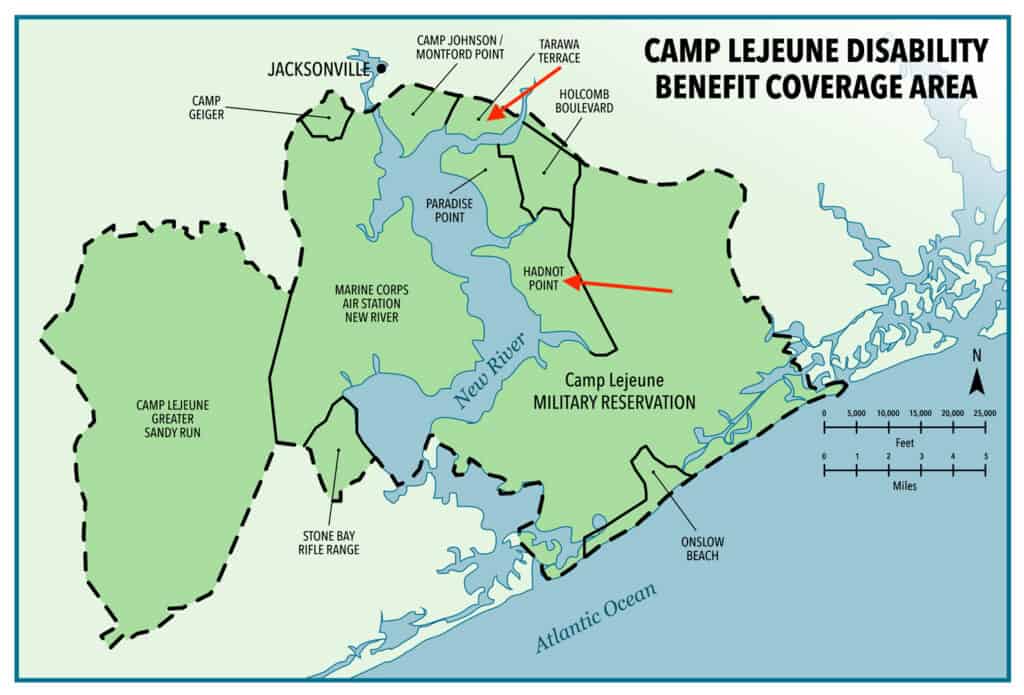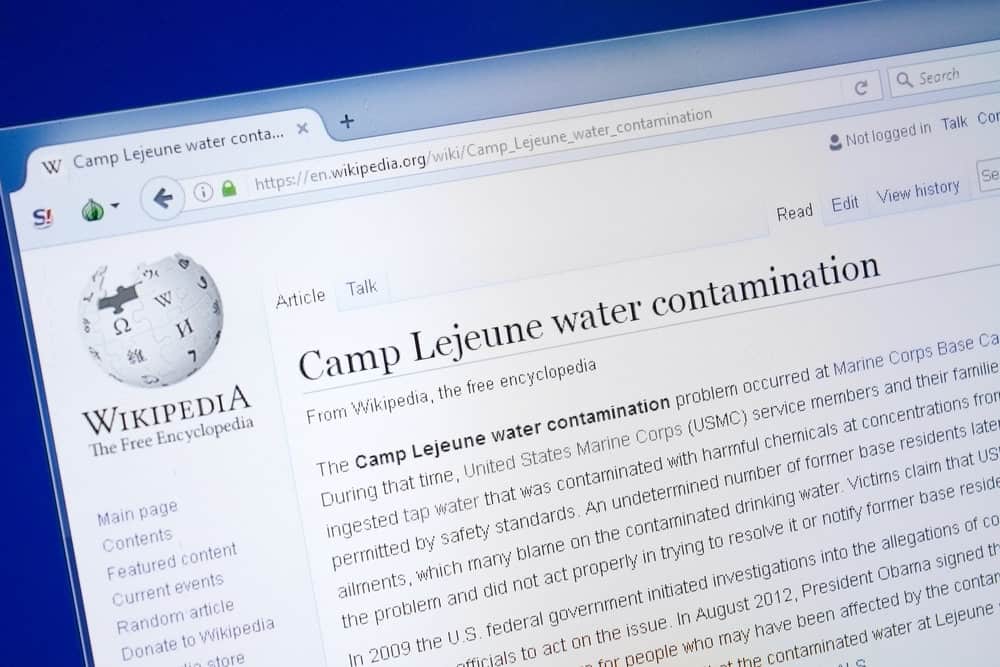In the past several decades, a severe environmental issue has come to light at Camp Lejeune, a US Marine Corps base in North Carolina. The primary concern stems from the discovery of contaminated drinking water that had negative neurobehavioral impacts on those who lived and worked on the base. The water contamination, caused by high levels of toxic chemicals in the water, has led to many health problems, both for the military personnel who served and their family members who resided there.
The full extent of the neurobehavioral effects from exposure to Camp Lejeune’s contaminated water is still under investigation, as scientific research has identified several chemicals that could have led to these adverse outcomes. As studies continue, efforts are being made to address the concerns of affected individuals and prevent similar situations from occurring in the future.
Key Takeaways
- Contaminated water at Camp Lejeune has led to neurobehavioral effects and health issues.
- Ongoing research aims to assess and evaluate the full extent of the health impacts.
- Policy and legislation are being developed to support affected individuals and prevent future contamination.
Contaminated Water at Camp Lejeune
Camp Lejeune, a Marine Corps base in North Carolina, experienced a significant water contamination issue for several decades. The contaminated water at Camp Lejeune was caused by various chemicals, including trichloroethylene (TCE), perchloroethylene (PCE), benzene, and vinyl chloride. These chemicals seeped into the drinking water supply, exposing Marines and their families to dangerous levels of contamination.
The primary source of water contamination stemmed from on-site activities at the base, such as industrial operations and waste disposal practices. These activities led to harmful levels of chemicals contaminating water sources, putting the health and safety of the Marine Corps community at risk. The issue persisted for many years until it was finally addressed, and remediation efforts began.
The Camp Lejeune News: Latest Updates and Insights provides valuable information on the water contamination issue and its implications for veterans and their families. With a heightened awareness of the problem, numerous measures have been taken to address and support those affected.
In this case, one of the primary concerns is the neurobehavioral effects of prolonged exposure to these chemicals. Research has shown a correlation between chemical exposure and various neurological and cognitive issues, including memory loss, mood disorders, and developmental delays in children. These effects can pose a significant challenge for the individuals affected and their families, leading to additional medical, emotional, and financial burdens.
As a result of the Camp Lejeune water contamination incident, new legislation and policies have been enacted to ensure that similar situations do not occur in the future. These measures raise awareness of the potential hazards of contaminated water and the need for rigorous testing and monitoring to maintain safe water supplies. Furthermore, they aim to provide appropriate medical care and support to those affected by these incidents and ensure their long-term health and well-being.
Neurobehavioral Effects
Neurobehavioral effects refer to symptoms that affect the nervous system and manifest as mood, memory, and motor function changes. Exposure to contaminated water at Camp Lejeune has been associated with neurobehavioral disorders in individuals who lived and worked on the base.
Individuals exposed to the contaminated water at Camp Lejeune may experience various symptoms, some of which can severely impact their daily lives. These symptoms may include confusion, depression, tension, headaches, and fatigue. Insomnia, sensory disturbances, and motor function difficulties are also common.
Cognitive and coordination problems can result from exposure to contaminated water. Affected individuals may report problems with reaction time and attention. Additionally, impaired visuomotor coordination and deficits in attention may be observed. Memory problems can also be a significant concern for those exposed.
Emotional and behavioral disorders have been linked to contaminated water exposure. Anxiety may be heightened in these individuals, and mood swings can occur, leading to relationship and social problems. Behavioral problems, such as increased aggression or impulsivity, may be apparent in those affected.
In severe cases, individuals may experience serious neuropsychological disorders, including cognitive decline, dementia, and involuntary movements. Weakness and tremors could be signs of damage to the central nervous system. Furthermore, exposure to contaminated water has been associated with an increased risk of suicide among affected individuals.
In conclusion, the neurobehavioral effects of Camp Lejeune’s contaminated water exposure are vast and varied. The symptoms can range from mild cognitive problems to severe neuropsychological disorders. Understanding these effects is crucial for providing appropriate support and treatment to those impacted by the contamination at Camp Lejeune.
Related Health Conditions
Neurobehavioral effects of the contaminated water at Camp Lejeune have been linked to various health conditions. Exposure to water has been associated with an increased risk of developing different types of cancers and other health issues.
Cancer: Some of the cancers associated with exposure to Camp Lejeune water include bladder cancer, breast cancer, kidney cancer, liver cancer, lung cancer, multiple myeloma, and non-Hodgkin’s lymphoma. All these cancers have shown a higher prevalence among those exposed to contaminated water.
Parkinson’s disease: Recent studies have suggested a connection between exposure to contaminated water at Camp Lejeune and Parkinson’s disease. While further research is needed, this connection highlights the potential neurobehavioral and neurological effects of toxic chemicals on the human body.
Aplastic anemia, myelodysplastic syndromes, and adult leukemia: These hematological disorders have been observed in higher numbers among those exposed to water contamination at Camp Lejeune. The toxic chemicals in the water, such as benzene, have been linked to these blood-related disorders and adult leukemia.
Renal toxicity and hepatic steatosis: Exposure to harmful chemicals in the water has been associated with renal toxicity or kidney damage. Hepatic steatosis, or the buildup of fat in the liver, has also been observed in those exposed to the contaminants at Camp Lejeune.
Infertility: Some studies suggest that exposure to the chemicals in the water at Camp Lejeune may have caused infertility in both men and women. More research is needed to establish a definite link between infertility and contaminated water.
Scleroderma: Scleroderma, a chronic connective tissue disease, has been reported among individuals exposed to water contamination at Camp Lejeune. While the relationship between exposure to contaminants and the development of scleroderma is not yet fully understood, it is an area of ongoing research.
In summary, the neurobehavioral effects of Camp Lejeune’s contaminated water have been linked to a wide range of related health conditions, including various cancers, neurological disorders, blood-related disorders, and other health issues. While research is ongoing, it’s essential to recognize the potential impact of exposure to these harmful chemicals on human health.
Those suffering from any of the above health conditions should immediately contact a lawyer handling Camp Lejeune claims and cases as you and your family may be entitled to compensation from a government fund.
Affected Population
The neurobehavioral effects of Camp Lejeune’s water contamination have impacted many people. This includes military service members stationed at the North Carolina base and their family members and civilians who worked or lived on the premises.
The contaminated water at Camp Lejeune posed severe health risks to the exposed population. Various illnesses, such as cancers, reproductive issues, and neurological disorders, have been reported. The long-term consequences of water contamination are still being uncovered, with an emphasis on understanding the full scope of the problem.
As more individuals come forward with their health concerns, the role of Veterans Affairs has become increasingly important. The department is responsible for providing support and resources to those affected by the Camp Lejeune water crisis. This includes compensation, healthcare, and various programs to assist the affected population in coping with the long-lasting effects of the exposure.
The ongoing struggle of Camp Lejeune victims sheds light on the urgent need for justice and accountability. Efforts to seek redress continue, with individuals sharing their stories and raising awareness about the neurobehavioral effects of the contaminated water. The fate of those exposed to the toxic substances in the water supply remains at the center of attention as they face an uncertain future and challenging health battles.

Disability and Compensation
Exposure to contaminated water at Camp Lejeune has led to neurobehavioral effects among veterans and their families. As a result, the Department of Veterans Affairs (VA) provides disability benefits and compensation to eligible individuals who have developed specific presumptive conditions.
These benefits cover certain medical expenses and lost income due to their disability. Veterans diagnosed with a presumptive condition may be granted service connection, which means the VA presumes that the individual’s medical condition is a direct result of their military service at Camp Lejeune.
Several presumptive conditions are associated with exposure to the contaminated water at Camp Lejeune. These include neurological disorders, PTSD, and other health issues that can significantly impact the lives of those affected. Veterans who believe they may have a service-connected condition can file a claim, seeking Camp Lejeune Water Contamination Settlements.
To receive disability compensation, applicants must provide evidence of their medical condition, their service at Camp Lejeune, and proof of exposure to contaminated water. The U.S. Department of Veterans Affairs reviews each case individually, determining the appropriate level of benefits based on the severity of the disability and its impact on their daily life.
Affected veterans must keep records of their medical treatments and submit thorough documentation supporting their claims. This can increase the chances of receiving the compensation they deserve. If the applicant’s claim is initially denied, they may appeal the decision and provide additional evidence to strengthen their case.
In conclusion, disability compensation is available for veterans with neurobehavioral issues or other presumptive conditions due to exposure to contaminated water at Camp Lejeune. Filing a claim with the Department of Veterans Affairs can provide affected individuals with financial support and reimbursement for medical expenses resulting from their service-connected disability.
Policy and Legislation
The Agency for Toxic Substances and Disease Registry (ATSDR) has been diligently working to understand the extent of the contamination and its potential effects on human health at Camp Lejeune. In response to the toxic water issue, the U.S. government has enacted multiple policies and legislation to address the situation.
The Camp Lejeune Justice Act is one crucial legislation that provides proper compensation and medical care to those exposed to contaminated water. The primary goal of this act is to ensure that eligible veterans and their families receive the necessary support and justice for the health issues they have suffered as a result of the exposure.
Pregnant women exposed to the toxic water at Camp Lejeune have reported experiencing in-utero complications, miscarriages, and other health concerns. Thus, the policy and legislation mainly focus on supporting the affected individuals and their families.
While the Camp Lejeune Water Contamination Lawsuits have helped shed light on the severity of the issue and its various health problems, it is essential to continue raising awareness and enforcing policies that promote a cleaner, safer environment for military personnel and their families.
In conclusion, the policy and legislation efforts, such as the ATSDR and the Camp Lejeune Justice Act, demonstrate the U.S. government’s commitment to addressing the longstanding issue of water contamination at Camp Lejeune and supporting those affected by toxic water exposure.
Assessment and Evaluation
Assessing the neurobehavioral effects of Camp Lejeune water contamination requires a thorough and rigorous approach. Environmental research plays a crucial role in determining the extent and nature of the contaminants in the environment, directly influencing the potential health consequences for those exposed to polluted water sources.
A widely utilized tool for conducting in-depth evaluations of neurobehavioral functioning is the Neurobehavioral Evaluation System (NES). This comprehensive testing mechanism allows researchers and clinicians to measure various aspects of cognitive and motor functioning, which could be impacted by exposure to hazardous substances such as volatile organic compounds (VOCs) and other contaminants found in the drinking water of Camp Lejeune.
The Adult Environmental Neurobehavioral Test Battery (AENTB) is another essential instrument frequently employed to evaluate environmental contaminants’ neurobehavioral effects. This test battery assesses multiple domains, including attention, memory, motor skills, and mood, providing a well-rounded understanding of an individual’s neurobehavioral status. The AENTB has been utilized in numerous environmental research studies, making it a reliable and robust method for examining the potential adverse effects of the contaminated water on the health outcomes of Camp Lejeune residents and workers.
When conducting assessment and evaluation studies, it is crucial to maintain a high level of methodological rigor. This includes carefully selecting study samples, accounting for potential confounders and biases in the research design and data analysis, and utilizing multiple data sources, such as self-report questionnaires, standardized tests, and clinical assessments. The integration of these various components helps ensure that the resulting conclusions are reliable and accurate, providing a solid foundation for developing targeted interventions and policy recommendations in response to the findings.
In summary, assessing and evaluating the neurobehavioral effects of Camp Lejeune water contamination involves a comprehensive approach that combines rigorous environmental research with reliable and robust assessment tools such as the Neurobehavioral Evaluation System and the Adult Environmental Neurobehavioral Test Battery. By employing such measures, researchers and clinicians can better understand the extent and impact of the contamination and subsequently inform decision-makers to take appropriate actions for those affected.
Conclusion
The neurobehavioral effects of Camp Lejeune water contamination have been a significant concern for many individuals. The toxins in the water, such as trichloroethylene (TCE) and perchloroethylene (PCE), have been linked to various neurological and behavioral issues.
Research has shown associations between exposure to these contaminants and an increased risk for neurodevelopmental disorders, cognitive impairments, and mood disorders. In particular, they have been observed to impact memory, attention, and executive functioning. These effects can lead to significant challenges in the daily lives of those affected, both in the short and long term.
Addressing the water contamination issue at Camp Lejeune has involved extensive efforts to remediate the site and offer support to the affected population. This has included measures such as providing health care assistance to veterans and their family members and conducting further research to understand the extent of the problem and potential solutions.
It is crucial to monitor the situation at Camp Lejeune and other locations where similar issues may arise. In doing so, we can ensure the health and safety of communities and work towards mitigating the adverse neurobehavioral effects associated with exposure to environmental toxins.



